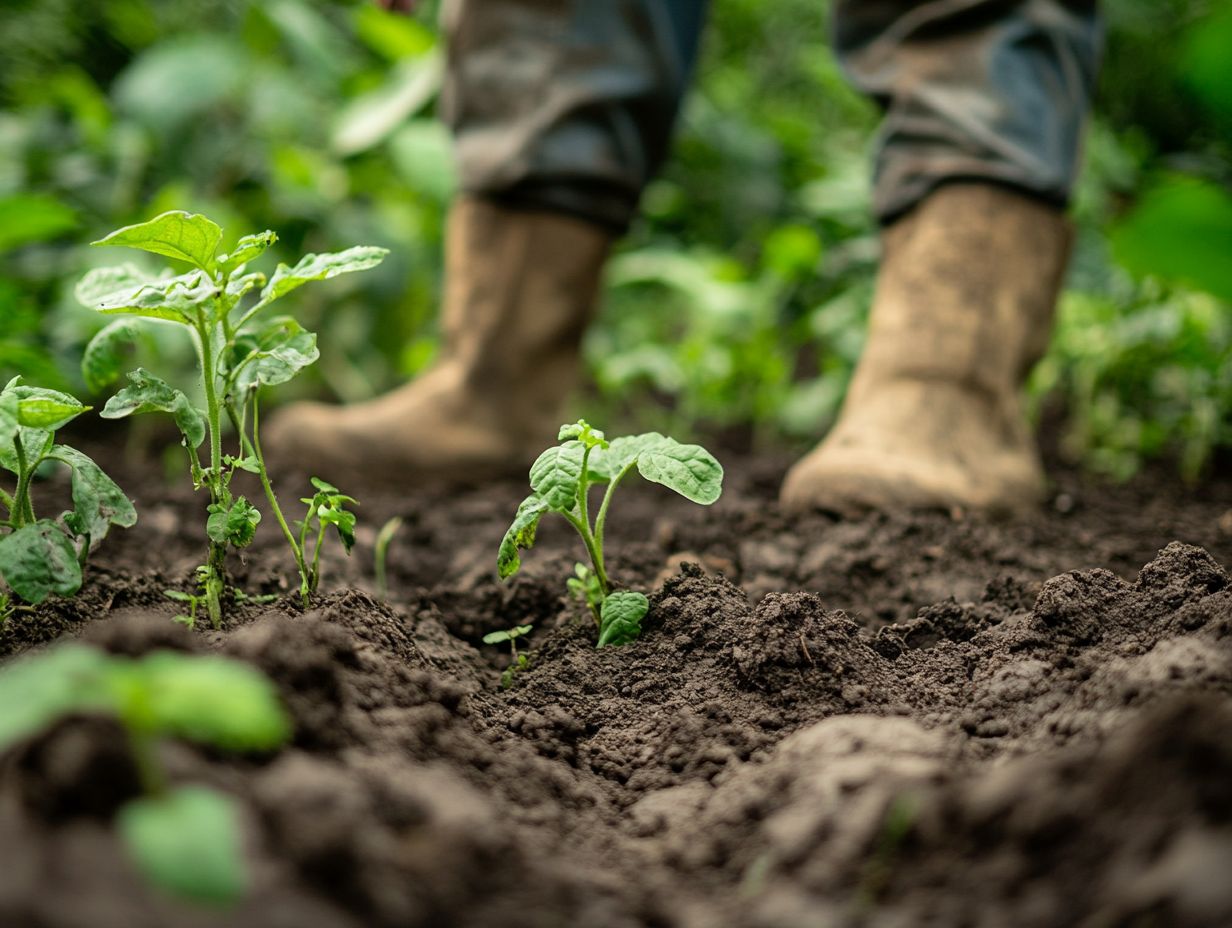How to Recognize Soil Health Issues Early
Soil health serves as the cornerstone of thriving ecosystems and productive agriculture, yet it often goes unnoticed in its important role.
To maintain soil quality, it’s essential to comprehend what defines healthy soil, identify visual and plant health indicators that may signal trouble, and recognize the underlying causes whether they stem from environmental factors or human activities.
This article delves into common signs of soil health problems, offering practical strategies to prevent them and effective solutions to address issues as they arise. Join us on this journey as we uncover the secrets to keeping our soil vibrant and resilient.
Contents
- Key Takeaways:
- Understanding Soil Health
- Common Signs of Soil Health Issues
- Causes of Soil Health Issues
- Preventing Soil Health Issues
- Treating Soil Health Issues
- Frequently Asked Questions
- What are some common signs of soil health issues?
- How can I recognize soil health issues early?
- What are some indicators of poor soil health?
- What are the benefits of recognizing soil health issues early?
- How can I improve soil health if I notice early signs of issues?
- What resources are available for me to learn more about recognizing soil health issues early?
Key Takeaways:

- Regularly monitor your soil for visual and plant health indicators to catch potential issues early.
- Environmental factors and human activities can significantly impact soil health; be aware of these potential causes and take preventative measures.
- Maintaining soil health requires consistent effort and best practices, such as proper crop rotation and using organic fertilizers. If issues do arise, effective solutions are available to treat them.
Understanding Soil Health
Understanding soil health is essential for maintaining agricultural productivity. It ensures the long-term sustainability of your farming practices.
This understanding requires a close examination of various factors, such as soil nutrients, biological diversity, and physical properties that contribute to overall soil quality.
By prioritizing soil health, you will significantly enhance crop performance and prevent nutrient deficiencies, ultimately supporting the vitality of your crops. Evaluating key elements like soil structure, organic matter, and moisture conditions is crucial for effective soil management and conservation efforts.
What is Soil Health?
Soil health refers to your soil’s ability to function as a vibrant ecosystem, delivering essential services for plant vitality and agricultural productivity.
This involves several factors, with nutrient status being paramount for growth and vigor, alongside the level of microbial activity. These microorganisms are not just bystanders; they play crucial roles in nutrient cycling, which is the process of nutrients moving through the soil and plants, and in the decomposition of organic matter.
When soil functions effectively, it enhances water retention, aeration, and overall fertility, leading to robust root systems and healthier crops.
Maintaining soil biological diversity is essential for resilience against pests and diseases while nurturing a balanced ecosystem.
These interconnected elements are foundational to sustainable agricultural practices, empowering you to cultivate land in a manner that supports productivity today while safeguarding it for the future.
Common Signs of Soil Health Issues
Common signs of soil health issues can manifest in various ways, significantly impacting your crop yields and agricultural productivity. It’s crucial to recognize indicators such as soil compaction problems, poor soil structure, and visible nutrient deficiencies for effective soil management.
Being attuned to these signs is vital; act quickly when you notice them to protect your soil’s health. Neglecting these indicators can lead to a gradual decline in soil health, which won’t just affect your current crop performance, but could also jeopardize the long-term sustainability of your farming practices.
Visual Indicators
You might notice visual indicators of soil health issues, such as uneven soil color, a lack of soil cover, and signs of erosion control problems all of which can significantly impact soil quality.
These visual cues are essential markers in assessing the overall health of soil ecosystems. For example, variations in soil moisture can lead to changes in texture and color, highlighting underlying issues like compaction or nutrient depletion.
Proper soil aggregate formation is crucial for maintaining soil structure, enhancing water retention and root penetration. In terms of erosion control, practices like planting cover crops not only provide immediate visual indicators but also contribute to long-term soil stability by reducing surface runoff and promoting healthier soil dynamics.
By closely observing these factors, you can greatly enhance your ability to develop effective soil management strategies.
Plant Health Indicators

Plant health indicators, like stunted growth and yellowing leaves, point to deeper soil issues. They remind us that crop vitality is intertwined with the health of the soil beneath.
Research shows that lacking key nutrients especially nitrogen, phosphorus, and potassium can reduce yield and quality. For example, a maize study found that nitrogen-deficient crops produced 30% less grain.
Moreover, insufficient phosphorus can hinder root development, complicating the challenges plants face. By understanding these connections, you can make informed decisions that underscore the importance of balanced soil health. This means you can take action today for a healthier tomorrow!
Causes of Soil Health Issues
The causes of soil health issues fall into two main groups: environmental factors and human activities. Both can greatly affect soil quality.
Elements like climate change, erosion, and soil compaction can compromise soil structure. Certain agricultural practices, such as the overuse of fertilizers and growing the same crop year after year, can disrupt nutrient cycling and the balance of soil ecosystems.
It s essential to recognize these causes so you can implement effective soil management and conservation strategies.
Environmental Factors
Soil erosion, climate changes, and moisture fluctuations can harm soil health. These elements strip away nutrients and disturb the microorganisms that keep soil fertile.
When the integrity of the soil is compromised, agricultural yields can decline, threatening food security and ecosystem stability. Thus, nurturing healthy soil ecosystems is crucial.
By adopting practices such as erosion control through cover crops, maintaining vegetation, and incorporating organic matter, you can effectively counteract these negative impacts. These strategies foster moisture retention and enhance nutrient cycling, ensuring landscapes remain productive.
Human Activities
Modern farming practices often degrade soil health through nutrient imbalances and reliance on chemicals. These actions disrupt soil ecosystems and threaten biodiversity.
To counteract these issues, embrace sustainable alternatives such as:
- Crop rotation
- Cover cropping
- Organic farming methods
Utilizing soil testing helps you make informed decisions, gaining insights into your soil s unique needs. By prioritizing soil health, you enhance agricultural productivity while contributing to a healthier environment.
Preventing Soil Health Issues
Preventing soil health issues requires commitment to sustainable agriculture. Techniques like crop rotation and cover crops can enhance soil structure and organic matter.
Regular soil testing helps you maintain nutrient levels. This supports agricultural productivity and contributes to a healthier environment for future generations!
Best Practices for Maintaining Soil Health

To maintain exemplary soil health, you should embrace sustainable practices such as crop rotation, cover cropping, and regular soil testing. These actions help monitor nutrient levels.
These strategies do more than just foster healthier crops. They enhance the soil’s structure and nutrient availability. By practicing crop rotation, you prevent the depletion of specific nutrients that crops rely on.
Meanwhile, cover cropping acts as a shield against erosion and boosts organic matter in the soil. Regular soil testing equips you with a comprehensive understanding of the nutrient profile and pH levels.
This knowledge enables you to make informed decisions about necessary soil amendments. Additionally, incorporating organic matter like compost or manure dramatically boosts soil biological diversity by offering habitats and nourishment for beneficial microorganisms.
This ultimately elevates overall soil quality and resilience against environmental pressures.
Treating Soil Health Issues
Addressing soil health issues requires a comprehensive approach that combines various effective solutions. You can incorporate organic amendments, fine-tune your crop management strategies, and apply biological management practices to rejuvenate degraded soil.
You can also implement targeted interventions, such as boosting microbial activity and encouraging earthworm populations. These actions notably enhance soil function and elevate overall agricultural productivity.
Effective Solutions for Common Problems
Effective solutions for common soil health challenges involve practices designed to improve nutrient cycling, enhance soil structure, and implement appropriate amendments.
By incorporating strategies like cover cropping, reduced tillage, and organic fertilization, you can effectively tackle nutrient deficiencies that impede crop production.
Fostering soil biological diversity is essential. Techniques such as introducing diverse crop rotations and implementing composting not only boost microbial activity but also enhance resilience against pests and diseases.
According to authoritative guidelines from the USDA and the Natural Resources Conservation Service, regular soil testing and tailored management practices are crucial for maintaining optimal soil health and productivity.
These actionable steps ensure a sustainable approach to farming that benefits both the soil ecosystem and the broader environment.
Frequently Asked Questions
What are some common signs of soil health issues?
Some common signs of soil health issues include changes in soil color, texture, and structure, decreased crop yields, and increased erosion.
How can I recognize soil health issues early?

Early recognition of soil health issues involves regular visual inspections of the soil, analyzing soil test results, and monitoring crop growth and development.
What are some indicators of poor soil health?
Indicators of poor soil health include low levels of organic matter, high levels of compaction, the presence of chemical residues, and a lack of beneficial soil organisms.
What are the benefits of recognizing soil health issues early?
Recognizing soil health issues early allows for timely and targeted solutions. This can prevent further degradation of soil and ensure optimal crop growth and productivity, as discussed in the article on understanding soil health indicators.
How can I improve soil health if I notice early signs of issues?
Improving soil health can involve implementing sustainable agricultural practices such as crop rotation, cover cropping, reduced tillage, and using organic amendments to increase soil organic matter.
What resources are available for me to learn more about recognizing soil health issues early?
Numerous resources are available, including agricultural extension offices, soil health workshops, conferences, online courses, webinars, and publications from reputable organizations like the USDA and NRCS.
Start exploring these resources today to become more informed about soil health!






